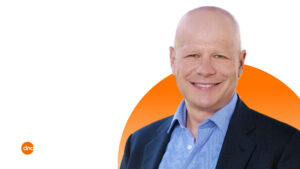Confidently Off the Cuff – Mastering Impromptu Speaking with Matt Abrahams
Have you ever been put on the spot to speak in front of a group, only to feel your heart race and your mind go blank? It’s a common fear, but one that can be conquered. Join us on this episode as we chat with Matt Abrahams, a Stanford University lecturer, podcast host, and author of the book “Speaking Up Without Freaking Out.” He shares practical tips on how to confidently speak impromptu, even when you don’t know the answer. You’ll learn how to overcome presentation anxiety and use simple go-to frameworks to ace any unexpected speaking opportunity. Get ready to speak up without freaking out.
Episode Guest

Matt Abrahams is a dynamic and innovative educator, coach, author and podcast host.
He teaches at Stanford University and is the author of the book “Speaking Up Without Freaking Out: 50 Techniques for Confident, Calm, and Competent Presenting” which provides practical strategies for managing anxiety and becoming a more effective communicator in any setting. Matt has received numerous awards and honors for his work, including the Circle of Excellence Award from the Council for Advancement and Support of Education in 2021 and the Robert K. Jaedicke Faculty Award from Stanford GSB in 2018.
Follow Matt and get all of his tips and practical resources at: nofreakingspeaking.com
Podcast Host

Stuart Paap is laser focused on helping more people unlock brilliant and bold ideas. He works with pioneering biotechs and healthcare companies, and regularly presents at universities and tech incubators like the Harvard Innovation Lab. He’s also a former stand-up comedian and is a yellow belt in Judo, which strikes fear into no one.
Podcast Timeline
- 05:49 - A Go-To Framework for Spontaneous Speaking
- 08:48 - Fear or Excitement? Framing Presentation Anxiety
- 10:59 - Reducing Nerves: Creating an Anxiety Management Plan
- 13:50 - Why It’s Okay to Say “Uh” and “Um”
- 17:06 - Using Your Voice as a Tool
- 24:33 - How to Respond to Tough Questions
- 26:06 - Dare To Be Dull: Achieving Greatness with Mediocrity
- 29:58 - Engaging Audiences Through the Screen

Podcast Transcription
Stuart Paap:
00:00
Welcome to Stand Up to Stand Out, the podcast. I’m your host, Stuart Paap. And for the last decade plus, I’ve been working with innovators and leaders inspire others to take action. My goal with this podcast is to give you practical, tactical advice that you can use now. Whether you’re scaling a company, leading a new team, or advocating for meaningful change, this show is designed to help you make a positive impact with those who count. So let’s learn together and have some fun along the way. Let’s get to it. Well, I am so thrilled to have Matt Abrahams on the show. So Matt Abrahams is a passionate, collaborative, innovative educator, coach, and podcast host. He’s the author of Speaking Up Without Freaking Out: 50 Techniques for Confident, Calm and Competent Presenting. Nice alliteration, Matt. He’s the host of Think Fast and Talk Smart: The Podcast. I love this podcast. Season four is coming up.
Some past guests of note, Robert Cialdini, author of Influence, Kelly McGonigal, who talks about anxiety. She has a phenomenal TED Talk. Andrew Huberman, who has this bonkers podcast, the Huberman Lab, and he talks about neuroscience and more tips. You should absolutely check out this podcast. And Matt also curates the nofreakingspeaking.com. It’s my pleasure to have Matt Abrahams on the show. Thank you, Matt.
Matt Abrahams:
01:30
Thank you for having me here, Stuart. I’m excited for our conversation.
Stuart Paap:
01:35
So I want to get right to your origin story, and you tell a great story about being a 14-year-old young man and having an opportunity to do some public speaking. And 14 is not, those are not easy times for anybody. And you had this packed crowd and you had a topic which was karate. And I’ll let you take it from here, Matt, but can you tell us what happened when you were trying to address the crowd and open up with a bang and things didn’t go according to plan?
Matt Abrahams:
02:06
It was more of a rip than a bang, but yes, well, great to be with you. And nothing like starting with my most embarrassing moment ever, so thank you, Stuart. When I was younger, I was requested by a teacher to go present at a speech competition, to talk about something I was passionate about then and still. I’m a big martial artist and I wanted to start a speech on karate and the importance of karate in my life and how I could value other people with a karate kick to get people’s attention. But I was so nervous that I forgot to put on my special karate uniform, karate pants that have a little extra room. So I was in my regular street clothes and I did a karate kick and literally ripped my pants from zipper to belt loop in the first 10 seconds of a 10-minute presentation.
And very few people, I think Stuart, can look at a point in their life where at that moment it was decided what they were going to do work on and be passionate about. And at that moment I learned the influence of anxiety on communication. And that’s something that’s motivated my research, my teaching, my writing to try to help people feel more comfortable and confident. So as a 14-year-old boy early on a Saturday morning, I learned my purpose, I think.
Stuart Paap:
03:19
Well, I love how you take, this is a great story, and I think we can all relate to some part of that where we want something.
Matt Abrahams:
03:25
I don’t know what part, I hope not the ripping of the pants.
Stuart Paap:
03:28
I don’t, maybe, but it’s wanting something in it, not going according to plan. And of course it went and you managed it, you got through it. But I think the fact that it set off this path. But when did you think you fell in love with communication or speaking, or just when did that bug get you, Matt?
Matt Abrahams:
03:47
But I’ll tell you, I’ll share with you a story that really ignited my curiosity about communication. When I was about seven or eight, my mother got frustrated with all the toys and junk that my younger brother and I had. She said, “We’re going to have a garage sale.” And where I grew up every weekend, there were always garage sales around. And my mother said that in order for us to stand out from all the other garage sales, we need to spell our garage sale signs wrong. So she instructed my brother and me to insert the letter B in the middle of garage, which ends up spelling garbage. So while everybody around us was having a garage sale, we were having a garbage sale. And we did better than anybody else in our neighborhood that weekend. And to this day, my mother attests that it’s because we had a sign that stood out.
I personally think people thought we were stupid and would get better deals. But the point is, at that moment I learned that communication, wording, language messaging can impact things. And that carried with me, still to this day, I’m fascinated by language. In terms of speaking being easier for me than perhaps for others, with a last name that starts with the first two letters A, B. In school, I was always called on to go first. It was always alphabetical order. So I really was always the first one speaking, not because I chose to, but because my last name afforded me that opportunity. And so I got very comfortable speaking off the cuff and in the moment because I was often put on the spot to do so. Those two things I think pointed me in the direction of being interested and more comfortable with speaking in front of others.
Stuart Paap:
03:28
That’s a great story, and I think there’s something about that reframing the garbage or garage as garbage, so let’s get to that first topic then, impromptu speaking. How do you think about impromptu speaking for people who are terrified of it for a variety of reasons and give them some tools to manage impromptu speaking?
A Go-To Framework for Spontaneous Speaking
Matt Abrahams:
05:49
Yes, speaking in the moment, if you think about it is what we do most often. We think about speaking as these big formal presentations where we practice, we put slides together, we maybe actually ask people for feedback. But in our personal and professional lives, most of the time we’re speaking in the moment. Somebody asks a question, somebody asks you for feedback, you have to introduce somebody, you make a mistake and you have to fix it. That’s mostly spontaneous speaking. So that’s where we really should focus our efforts. And many of us are nervous about plan speaking and when it comes to in the moment speaking, it can be even worse. So there are lots of things we can do to help manage anxiety regardless of if it’s spontaneous or planned. But I want to touch on what you said about a framework, a map. I am a huge proponent of structure.
I think structure is critical in all communication, but especially spontaneous speaking. When you think about it, in the moment, when somebody puts you on the spot to speak, you have two fundamental tasks to deal with. You have to figure out what to say and how to say it. A structure gives you the way to say it. So it’s like you open up the refrigerator and you see all these potential ingredients. The recipe tells you how to put those ingredients together, and that’s what a structure does. So I have a structure, there are many structures, but I have a structure that I love. I think, Stuart, you know where I’m going with this. It’s three simple questions. It’s what, so what, now what? And you can do a lot with those three questions. So if you ask me to share about my background for a job interview, you might say, “Matt, what qualifies you? What’s your experience?”
I can tell you what my experience is. I can tell you why that’s important. That’s so what, and now what I can tell you how my experience will help me in this job. Or imagine, Stuart, at the end of this podcast, you might say, “Hey, you’re a podcaster. Give me some feedback.” I could say, “What?” That’s my feedback. I could say, “So what?” That’s why I think what I said is important and then now what would be my recommendation for what you do in the future. So by using the simple structure of those three questions, I know how I’m going to say what I need to say. So I now only have to work half as hard. So one of the great ways to manage anxiety and impromptu speaking is to have some structures you can rely on to make your life a little bit easier.
Stuart Paap:
08:07
It’s a great framework and it reminds me of that quote that we don’t rise to the level of our expectations, but we fall to the level of our training. I’ve been doing this for 20 years, public speaking, and I’ve been doing it even longer if I include high school. And it’s always interesting to me how the emotions are always there no matter the situation. And I’ve learned over the years how to manage them but I’m curious how you’ve learned to manage your feelings. And I’m not trying to label them, by the way, feelings are just feelings. I’m not saying good, bad, or indifferent. How have you learned to not manage those? And then what do you advise others to manage theirs?
Fear or Excitement? Framing Presentation Anxiety
Matt Abrahams:
08:48
So there’s some really fascinating research from my friend and colleague, Alison Wood Brooks, out of Harvard. She teaches in Harvard’s Business School. And many, many years ago, she did some research that said essentially the feelings we have when we get nervous about speaking, the physiological response that we have is pretty much identical to the physiological response we have when we’re excited or when something good happens. So if I go to you Stewart and say, “Hey, you won a million dollars in the lottery.” Your heart rate would go up, you’d perspire, you’d shake a little bit, but you’re really happy to be having those feelings. But if I said, “Hey Stewart, guess what? Joe can’t make the meeting today. I need you to present.” Your heart rate goes up, you start sweating, start shaking, and that’s not so positive. So part of the way to manage our anxiety or just feelings we have around communication is to reframe them as something positive.
And it’s much easier to just change your mindset than it is to manage all of the physiological symptoms. So just ride those symptoms, but look at them differently. So one way of managing anxiety is to reframe the situation as not one of fear, but one of excitement. I have an opportunity to share my thoughts, to explain my position, to get you interested in what I’m interested in. Those are things that are exciting. Now that said, there’s still things that we can do.
Those are things that are exciting. Now that said, there’s still things that we can do to manage symptoms. Deep breathing is incredibly important. What’s really important about deep breathing is the exhale, not the inhale. So the rule of thumb, or as I like to joke, the rule of lung, is that you want your exhale to be twice as long as your inhale. And if you take two or three deep breaths with long exhalations, you can reduce that anxiety or fight or flight response. If you’re somebody who gets really shaky, doing some big broad gestures, taking some steps forward can help. So there are things that you can do to manage both symptoms and sources of anxiety that help you feel more positive about the experience. Believe it or not, it can be exciting to speak in front of people. Many of us are like, “Oh my goodness, I can’t imagine that.” But it can be if you get the right mindset and deal with some of the symptoms that you have.
Stuart Paap:
10:52
And so do you use those for your own feelings when you have an opportunity, or what’s your playbook for you?
Reducing Nerves: Creating an Anxiety Management Plan
Matt Abrahams:
10:59
Yeah, I heard your question about me specifically. So thanks for bringing it back to the topic. So yes, I still get nervous in some circumstances. There are some speaking situations that I am not fond of. And I have what I call an anxiety management plan. And all of my students and all the MBA classes I teach and all the people I coach, I recommend generate or create their own anxiety management plan. And to me, an anxiety management plan is three to five techniques that can work for each person to help them feel more comfortable and confident in communication. And I have my own, and I’ve been using it for years.
It consists of three parts. I, when I get nervous, I get very sweaty and I blush, so I need to cool myself down. There’s a reason that we heat up when we get nervous or excited, so we need to cool ourselves down. So a great way to do it is to hold something cold in the palms of your hand. The palms of your hand are thermo regulators for your body. If you’ve ever held warm coffee in the morning in a cup and felt it warms you up, I just do the same thing in reverse. I hold something cold, a cold bottle of water reduces my sweating, reduces my blushing. I am somebody who can live in the future. I’m always thinking about what’s next or where I need to take my audience, and I can get nervous about what might happen in the future. So I need to get myself present oriented.
So the second step of my anxiety management plan, and this is going to sound silly, Stuart, but I say tongue twisters and I say them out loud. It warms up my voice. Before I speak, I’ll say two or three versions of the same tongue twister out loud. That gets me present oriented. You can’t say a tongue twister right if you’re not in the present moment. And then the final thing I do to work on my mindset is I remind myself that I have value to bring. So right before I speak, a lot of us before we speak say all these negative things to ourselves, like, “You’re going to screw up,” or, “You should have practiced more.” So what I’ll remind myself before I speak is I’ll say, “I have value to bring.” There’s something that I have to say that the audience will derive value from. In many cases, when I speak, people have chosen to be there. And those three things, holding something cold, saying tongue twisters, and reminding myself that I have value, that’s how I feel very positive about and not so nervous about my speaking.
Stuart Paap:
13:18
Got it. Well, that’s helpful. And I like the idea of that anxiety management plan because just by having a plan, it gives you something that you’ve been able to externalize what is likely not going to happen, but at least give you a toolkit to do it. What is your take on ums and uhs in public talks, and how do you advise people to deal with them if they’re nervous about them? Because oftentimes people bring that issue to me and I try to unpack it for them. What’s your response?
Why It’s Okay to Say “Uh” and “Um”
Matt Abrahams:
13:50
Yeah, so filler words, verbal graffiti, those are things that can bother people, both audiences and communicators. The reality is that they’re normal and natural for some of the reasons that you mentioned. They are a way of thinking and demonstrating we’re thinking. Actually some really interesting research showed with young children, and I know you have some young kids, that it actually is a way of signaling to kids as they’re learning language that what’s about to follow is something they should pay attention to.
So the um is sort of a warmup to say, “Hey, you should focus.” Now, obviously, if filler words become distracting, there’s so many that they take our attention away, they divert our attention from what’s being said, then that’s a problem. The rule of non-verbal presence, how you show up, is your non-verbal presence should not distract from what it is you’re trying to say. So if I have too many filler words, then I have to be careful. And let’s be clear. Some is normal and natural. In fact, screenwriters who write for television, plays, and movies, they will build in filler words into the dialogue, so it sounds normal. If somebody speaks eloquently, perfectly, no pauses, that doesn’t sound real. So it’s not having some, it’s having too many that’s the issue. And there’re two fundamental kinds. There’re the filler words that happen within what you’re saying, and they’re the ones that happen between what you’re saying. So I finish one thought, um, and then I start the next thought. And it is those between phrase or between sentence filler words that really stand out, and turns out, really bother people.
So to get rid of them, two suggestions. One, there’re tools that can help. You can’t change something you do not know you’re doing. And what you were talking about is that um buster role that Toastmasters have that count or raise a hand every time you say one. There are apps that can do that. There’s an app I like, it’s called Say It LikeSo. You have to pay a couple bucks for it. And it uses your phone’s microphone to record and document every time you say a filler word. So you become aware, it notifies you. There’s one that works for virtual communication, plugs into Zoom or Team or Meet. It’s called Poised. com. That one’s currently free. And that will tell you when you’re in the midst of these virtual meetings. So awareness building is the first step.
And then the second step is to really monitor your breathing. We often finish sentences still having air in our lungs. And when we have air in our lungs, we will often expel that air and say um, or uh, or so. So if you train yourself to end your phrases out of breath without getting quiet, I call this landing a phrase, then you actually are out of breath and have to inhale before you can speak again. And you can’t say um, oh, like, so, anything like that without breath. So if you land a phrase as I’m doing right now, I have to inhale and then speak my next phrase, I eliminate or severely reduce those filler words. So there’s some practical breathing speaking exercises you can do, but that only follows the awareness building. So again, it’s not about eradicating them. It is about reducing them so they do not distract your audience.
Using Your Voice as a Tool
Stuart Paap:
17:06
Well said. I want to talk about the quality of your voice, or speaking voice if you want to talk about something more general away from Matt Abrahams. But you have an incredibly nice voice. You practice, or at least it sounds clear, enunciated. There’s a timbre to it. So first question, and putting you on the spot, how much have you thought about managing the quality of your voice when you’re giving interviews, when you’re hosting your show, when you’re giving presentations? And then my second question is about managing the quality of others’ voices when there are all kinds of issues, whether it’s different cultures, different languages, different norms.
Matt Abrahams:
17:50
Yeah, it’s funny because my father has an amazing voice. He’s got a very deep, resonant voice. So when people tell me that I have a nice voice, I compare it to my father’s, so I don’t find it that particularly good. Now, do I spend some time thinking about it? Absolutely. Do I do breath exercises, and warm up my voice before I speak, and have some warm water before I go? Yes, I do those things, but I think that’s prudent for anybody who uses their voice as a tool. But it does matter. I invest in a nice microphone. You can’t see it in the shot, but I have a nice microphone sitting next to me.
So I do think about my voice. Do I go overboard with it? No. I think I have some genetic predisposition to have the voice that I do, but voice is important. And you’re right. It is something that is impacted and influenced by culture, by expectation. Some people are speaking a language that’s not their native tongue, and sometimes saying the certain phrases and words can be hard, but we need to practice and we need to take the time to think about our voice.
The best tool, and Stuart, you and I have the opportunity to do this all the time as people who host podcasts and do videos, you can listen to yourself and you can hear it, and you can say, “Oh, I like when I do that, or maybe I shouldn’t do this next time.” Recording yourself and listening is something that really needs to be challenged. So again, recording yourself and listening is something that I encourage everyone to do in any speaking situation just to prepare yourself, it’s good practice. And you can listen and see what you might want to change.
Stuart Paap:
19:29
Well, it’s interesting. I remember reading an article about Margaret Thatcher and Angela Merkel, both apparently who had vocal training before or during office. And apparently if you watch some tape on them before they took office and then after that they had deeper tone and more inflection in their tone. I find it tricky to give feedback around the quality of someone’s voice and trying to focus on objective factors, like how much volume are you using, how clear can we hear the word that-
How much volume are you using? How clear can we hear the word that you’re trying to share? So do you use these objective factors to help people work on their performance or their presentation?
Matt Abrahams:
21:15
So lots of questions in that point you just brought up. So let me address a few of them.
Stuart Paap:
20:20
Sure.
Matt Abrahams:
20:20
First and foremost, I believe in authenticity. I believe you should be who you are and speak the way you speak. To put on somebody else or the person you should or want to be, I think is hard. It’s extra work. We know from cognitive load theory that if I’m monitoring what I’m doing while I’m doing it, it gives me fewer resources to actually focus on what it is I’m actually doing.
Now that said, I do think warming up your voice, thinking about how you articulate things is very important. But I would much rather you feel comfortable in what you’re doing than to worry about some objective standard, where you’re sitting with some kind of hertz meter trying to figure out is my frequency the right frequency? That to me is less important, and I never coach people to say lower. I will say slower. I will say vary your voice more. Your voice is an instrument, use it as one. But I’m never saying, “Lower your timber.” It’s hard for people to do that.
Now, if you are going to become a professional speaker, that’s a different story. I would rather have people focus on being more authentic and using the tool that they have. That said, when it comes to non-native speakers, as you asked, with accents, et cetera, on my podcast I interviewed somebody who works with non-native speakers as a profession, and he said something that really I resonated with. And when I share it with the non-native speakers I work with, I teach, they also found it … In some ways it gave them a sense of relief. And it essentially it was your goal is not to sound like a native speaker. Your goal is to get your point across. And if you focus on getting the point across, that takes a lot of pressure off of you and you can do things easier and better than trying to reduce your accent.
So for example, I can make a point and then give another example to reinforce that point. Or I could make a point and then ask you a question to see if you understand. So all of a sudden it’s about fidelity, getting the information across in an accurate way. And it’s less about sounding like somebody who’s a native speaker. And for my non-native speaking students and people I coach, that that was very, very useful and important for them. So I’d like to pass that along to your listeners as well who are non-native speakers.
How to Respond to Tough Questions
Stuart Paap:
22:44
Excellent. One question I get often is people are really managing anxiety around getting questions, especially from senior leaders when they feel like they may not have an appropriate response, and it just terrifies them. How can I be prepared? So how do you coach people to respond in situations where they may be presenting on topics X, Y and Z, and they may get questions about everything else that they did cover, and there has to be some way to approach it. What’s your approach to that?
Matt Abrahams:
23:19
So there are three things I think about when I talk to people about this issue. First is you do have to prepare for Q&A. You would prepare for a formal presentation, you should prepare for Q&A. The way you prepare for Q&A is like you should prepare for any kind of communication. Really think about your audience and what’s important to them, and what they likely will need to know.
The biggest mistake people make in their communication, is they start from saying, “Here’s what I want to say,” rather than, “What do you need to hear?” And so first and foremost, think about what the audience might ask, and then prepare yourself to answer it. Now that does not mean memorizing and having lists and lists of information. It means given what I’m saying, what is likely to be important for these people? And then thinking through what questions might they ask, and maybe finding some ancillary supporting research information evidence that you could bring. So it’s not about pulling your hair out and really stressing over it. It’s about being pragmatic and planning.
The biggest mistake people make in their communication, is they start from saying, "Here's what I want to say," rather than, "What do you need to hear?"
When a question like that comes in, it’s important to give yourself some time. And the best way I know to give yourself some time is to paraphrase. Paraphrasing I think is one of the most important and useful communication skills. And when I say paraphrase, I don’t mean do what a five-year-old does, which is just parrot back what you say. It’s distill down the key essence of what’s being asked. It does several things for you.
First, it makes the person who asks the question feel validated, because you’ve just demonstrated, “I listened, or at least I tried to listen to you.” And then it also validates the accuracy of what you understood. No sense answering a question you were not asked. So it’s a fidelity check. Somebody could say, “No, no, what I really meant was this.”
The cool thing about paraphrasing is it is a lower order cognitive skill. What that means is, essentially, that we don’t have to use a lot of our horsepower, or mental horsepower to paraphrase. So part of us brain can be thinking about and planning our answer. So we have to prepare. When the question comes in, we need to do paraphrasing to buy ourselves a little bit of time. And then the last is, if you don’t know the answer, just say, “I don’t know.” And then immediately follow it up with, “Here’s what I’m going to do to find out.” And if you have an inkling or a hunch as what the answer might be, say that. So you might say, “I don’t know the answer. I’m going to go ask my friend Stewart. He’s going to give me a lot of information. I’ll get back to you in 24 hours. My hunch is this is where it’s going to be.” And as you said, that’s very reasonable. I don’t think most people, even the most strict commanding boss expects you to know everything. I think what they want to see is that, that you’re willing to find out and you have some ideas about how to find out. So those would be my three bits of advice for the situation of being really nervous about Q&A.
Dare To Be Dull: Achieving Greatness with Mediocrity
Stuart Paap:
26:06
I love that. In one of your talks you mentioned the dare to be dull piece of advice. Can you unpack that for the audience?
Matt Abrahams:
26:15
Yeah. So this is an idea that comes from the world of improvisation. And I’ve been very fortunate in my career to work with some amazing improvisers. I co-teach a class with somebody at Stanford on improvisation and speaking, and this is a famous maxim. There are lots of maxims from improv that I like. Everybody is, or many people, are familiar with, “Yes, and.” That’s probably the most famous. But this notion of dare to be dull essentially is reminding us that when we put pressure on ourselves to be great, we minimize the amount of cognitive effort and energy that we have to put into the task. Because part of us is judging, evaluating, monitoring what’s going on, which means we have less mental energy to dedicate to what we’re doing.
So I have the audacity in front of Stanford Graduate School of Business Students to say, “Strive for mediocrity.” And their jaws drop. You can literally see it, and you hear these gasps, but I finished that by saying, “Strive for mediocrity so you can achieve greatness.” And that gets them curious. “Well, what? There’s a way to achieve … What do you mean?” And it’s all about just get it done. If somebody asks you a question, just answer the question. If you have to summarize or update, just update and summarize. Don’t say, “I have to update and summarize perfectly. I have to get it right,” because so doing you make it less likely that you will do it well at all. Just do it, and in so doing, you actually have more resources to actually focus on doing it better. So dare to be dull, strive for mediocrity, it’s great wisdom that comes from improv to really say get out of your own way. I’m not saying we shouldn’t judge, I’m not saying we shouldn’t work hard. We absolutely should. But there are some circumstances where doing that, focusing on being perfect, getting it right, gets in the way of getting it done.
I’ve been doing this for a long, long time. Decades. And I am here to tell you and all your listeners, there is no right way to communicate. There are certainly better ways, and there are worse ways, but there is no one right way to communicate in every situation and to put pressure on ourselves to do it right is a fool’s errand because there is no right way. It is far better just to focus on getting it done.
Stuart Paap:
28:31
Right. You’re reminding me of practice techniques, or improv is about getting in action. But then there’s of course the rehearsal or getting mentally prepared or physically prepared. Speaking as a physical act, and I always encourage people to their comfort level. If you’re sitting at a desk all day grinding up formulas or spreadsheets or PowerPoint, get up and grab some index cards, walk around, just turn it into more of a kinetic activity. It doesn’t have to stay that way. I’m not suggesting pacing around a stage, but physicalize it if you can.
Matt Abrahams:
29:06
Yeah, absolutely. I liken speaking and communication to sport all the time. And movement is critical in sport, and I agree that movement is critical. There’s good research to say that we have embodied knowledge and when we use that, our bodies, we can get access to some of that. So it’s not just moving yourself, it’s also listening to what your body is telling you and reacting and responding to that. So I can’t tell you the number of my students who pull all nighters before a big presentation in a class, and their body’s telling them exhausted or they’re hungry or they should go exercise and they forego that information, and then they deliver a poor subpar communication. So I agree, get up, move, but also listen to what your body is saying and it might know something you don’t if it could help you in your communication.
Engaging Audiences Through the Screen
Stuart Paap:
29:58
We’ve suggested polls and questions and open-ended questions and calling people out and everything under the sun. What else or what do you suggest people do when they’re in that tough situation where it’s not the norm for the client to have to be on camera, on mic and be an active participant?
Matt Abrahams:
30:56
Well, could you make the situation harder, please?
Stuart Paap:
30:58
Yes. And language. No, all right. Anyway.
Matt Abrahams:
31:02
That’s great.
Stuart Paap:
31:04
Bad wifi.
Matt Abrahams:
31:04
Yeah, that’s one time I didn’t want you to a yes and for me. Very challenging, a very challenging situation, and I think you’ve tapped into some of the right ways. What you’re really talking about is engagement. And to me, engagement is sustained attention. We need people to pay attention to us in a sustained way for us to make our point, for them to see our logic, for them to feel part of what we’re doing, and all of the circumstances you’ve described in this question are working against engagement. There are three major ways I teach people to engage. There are physical, mental, and linguistic ways. I’m going to rattle off a few of these and some you’ve mentioned, but these can help.
Before I get into these three, I would also suggest that how your meeting invite is worded and the expectations you set in that meeting invite is part of a getting people engaged. Most of us don’t spend any time thinking about our meeting invite. We put the URL to the Zoom or the team or the meet and we give it some name and send it out. But if you in the invite say, “I’m really excited to meet with you. Here are the things that I believe you’ll take away from this,” so you start explaining the relevance and salience even before you speak, people might lean in more. They might be prepared to listen more because they see that there’s value to come.
Part of it is expectation setting. And that expectation setting starts before the Zoom starts. It starts in how you invite people, what you call the meeting, what you put in the meeting invite. The three types of engagement, once you get things going, physical engagement. You rattled off a bunch of these. Use polling, use a shared whiteboard. Show videos, show slides that aren’t just words and bullet points but might have images in them. Get people to see and experience something because where their body goes, their mind will follow. Have an experience for people.
If you ask people to do something physically, you must respond to what you do. I cannot tell you the number of people I see who take a poll… First, they don’t tell people how to respond to the poll, so they’ll just say, “How many of you had breakfast this morning?” And then nobody responds. Well, you didn’t tell them how. “Type it into the chat. Use a reactions button. Click on this here.” And then once people respond to the poll, you have to comment on it. “Oh, that’s half of you,” or, “That’s more than I thought,” or some kind of feedback, because that rewards that engagement. If you don’t reward the engagement, people feel tricked and then they’re less likely to engage. You have physical engagement that you must comment on once you get people to do it.
Comparisons help people get engaged. If you can compare what you're talking about to something people already know or are interested in, it can make a big, big difference.
The second type of engagement is mental, cognitive. And this is where asking questions, even if they’re rhetorical where you don’t expect an answer, can make a huge difference. Also, analogies. Comparisons. Comparisons help people get engaged. If you can compare what you’re talking about to something people already know or are interested in, it can make a big, big difference. You must be careful culturally, though, with comparisons, analogies and metaphors because sometimes it doesn’t translate. I make this point in all of MBC classes. In American business, we use a tremendous number of sports analogies, which is great if you know those sports. It’s a slam dunk. Push it across the goal line. But if you don’t know the sport, you lose out.
I had a student who proved this point in the opposite. In the middle of his speech, he gave an analogy to the game of cricket, and that’s what he heard in the entire… Nobody knew what the hell he was talking about and he stopped and he said, “That’s how I feel when all of you use analogies to American football.”
Stuart Paap:
34:29
Smart.
Matt Abrahams:
34:29
Analogies are powerful. We’ve got mental engagement, we’ve got physical engagement, and the final kind is linguistic engagement, language. Two types of language I want to talk about. Inclusive language. Use people’s names. Use the word you. Ever since we were little kids, we were taught that when you hear the word you, you should pay attention. Similarly, use time traveling language. “I can take you into the future. Imagine. What if. Picture this.” When I say those things, you see it, you’re engaged. Or I can take you into the past. “Think back to when. Remember when.” That takes you into the past. You see it in your mind’s eye. You’re engaged.
The situation you described is really hard, but if you prepare people by expectation setting in advance and use a variety of physical, mental, and linguistic engagement, I think you have a chance of getting them involved.
Stuart Paap:
35:21
Wow. All right, well, to honor the time constraints, I want to thank Matt Abrahams. Phenomenal piece of advice. This was really just a pleasure and honestly, I could talk to you for another few hours, but I’m going to let you go.
Matt Abrahams:
35:35
Thank you.
Stuart Paap:
35:36
You should check out nofreakingspeaking.com. You should also subscribe to Think Fast, Talk Smart. Did I get that right?
Matt Abrahams:
35:44
You got it right. The podcast. Please do.
Stuart Paap:
35:46
Yes. Which is amazing. Check out his book, and I think the best place to go, Matt, is to nofreakingspeaking.com. Is that correct?
Matt Abrahams:
35:55
That’s right. And I’m a big user of LinkedIn. If you’re on LinkedIn, feel free to link in with me.
Inside the Influence Lab
Episodes
Articles

Building a Strong Speak Up Culture for Business Success




Closing the Leadership Intent-Impact Gap




















